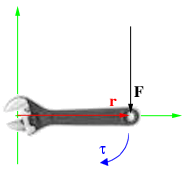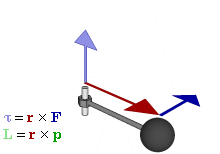Torque facts for kids
In physics, torque is like a special kind of force that makes things twist or turn. Imagine you are trying to open a tight jar lid. The twisting motion you use is an example of torque. It's what makes an object start spinning, or stop spinning, around a central point.
You can create torque by pushing or pulling on something. The amount of torque depends on how strong your push or pull is, and how far away from the center you apply that force. Think about using a long wrench to loosen a bolt – it's easier than using a short one because the longer wrench helps create more torque.
What is a Fulcrum?
A fulcrum is the fixed point around which something turns or rotates. It's like the pivot point for a lever. For example, when you use a seesaw, the support in the middle is the fulcrum. When you apply a force to one end of the seesaw, it rotates around the fulcrum.
How to Calculate Torque
We can use a simple equation to figure out how much torque is being made. The equation for torque looks like this:
Don't worry, it's simpler than it looks!
- The Greek letter τ (called "tau") stands for torque.
- F is the strength of the force you are using (your push or pull).
- r is the distance from the fulcrum (the center point) to where you are applying the force.
So, in simple terms, torque is calculated by multiplying the force you apply by the distance from the center of rotation. The bigger the force or the longer the distance, the more torque you get!
Units of Torque
Torque is measured in units that combine force and distance.
- In the SI system (the most common system used in science), torque is measured in newton-metres. This means a force in newtons multiplied by a distance in metres.
- In the English system, torque is often measured in foot-pounds. This means a force in pounds multiplied by a distance in feet.
See Also
 In Spanish: Momento de fuerza para niños
In Spanish: Momento de fuerza para niños




